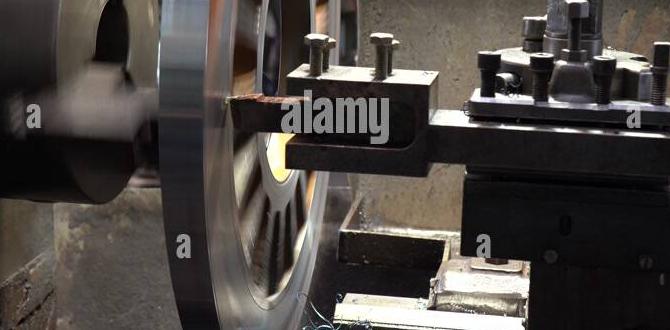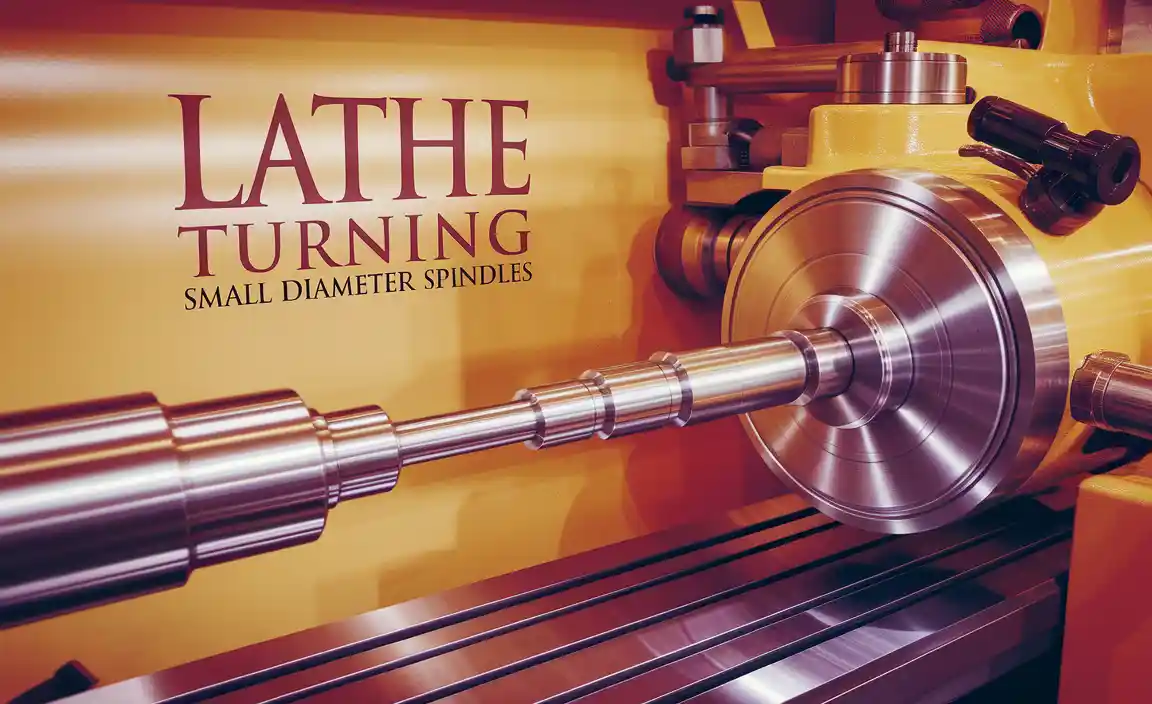Carbide end mills are crucial for achieving precise, tight tolerances in milling operations, especially with materials like Delrin. This guide explains why they’re essential and how to choose and use them for perfect results.
Ever get frustrated when your milling project just doesn’t come out quite right? You’re aiming for super accurate dimensions, those “tight tolerances” that make a big difference, but something’s just a little off. It can be a real headache, leaving you wondering what went wrong. The good news is, a lot of this precision comes down to the right tool. One of the most important players in achieving those perfect fits is the humble, yet mighty, carbide end mill. Stick around, and we’ll dive into why this tool is your new best friend for hitting those exact measurements, every single time.
What Exactly is an End Mill?
Before we get to why carbide is so special, let’s quickly cover what an end mill is. Think of it as a router bit, but for metal or plastic. It’s a type of milling cutter, meaning it rotates and removes material. Unlike a drill bit that only cuts downwards, an end mill has cutting edges on its sides as well as its tip. This design allows it to cut horizontally into a workpiece, create slots, shape contours, and machine flat surfaces. They come in various shapes, sizes, and are made from different materials, each suited for specific tasks.</p
Why Carbide Stands Out for Precision
When we talk about “tight tolerances,” we’re talking about very small acceptable deviations from a desired dimension. For example, fitting two parts together snugly without any wiggle room. Achieving this demands tools that are incredibly stiff, sharp, and don’t lose their shape or size during the cutting process. This is where solid carbide truly shines.
Here’s why carbide is your go-to for precision:
- Hardness: Carbide is exceptionally hard. This means it can cut through tough materials with ease and, more importantly for precision, it resists being deformed or worn down by the cutting forces. A sharp, un-deformed edge cuts accurately.
- Stiffness: Carbide is much stiffer than high-speed steel (HSS). This stiffness translates to less tool deflection under cutting pressure. When a tool deflects, it doesn’t cut to the intended dimension, directly impacting your ability to achieve tight tolerances.
- Heat Resistance: Machining generates heat. Carbide can withstand higher temperatures than HSS without softening, allowing for faster cutting speeds and feeds without compromising tool integrity or accuracy.
- Edge Retention: Due to its hardness, a carbide cutting edge stays sharper for longer. A consistently sharp edge is vital for predictable and repeatable cutting, which is the foundation of precision machining.
Understanding the “Carbide End Mill 1/8 Inch 6mm Shank Reduced Neck for Delrin Tight Tolerance”
Let’s break down that specific description because it tells us a lot about the tool’s purpose:
- Carbide End Mill: As we’ve discussed, this means the tool is made of solid carbide, built for hardness and stiffness.
- 1/8 Inch (or ~3mm) and 6mm Shank: This refers to the diameter of the part of the end mill that goes into your milling machine’s collet or tool holder. Having common sizes like 1/8 inch or 6mm is important for compatibility with standard tooling.
- Reduced Neck: This is a critical feature for tight tolerance work, especially in flexible materials like Delrin. A reduced neck means the shank (where it’s held) is a larger diameter than the cutting portion. This provides increased rigidity for the cutting head, preventing chatter and allowing for deeper, more aggressive cuts without sacrificing accuracy. It also provides clearance for the cutting head so it can reach into pockets without the shank hitting the sides.
- For Delrin: This indicates the end mill is optimized for cutting Delrin (also known as Acetal or POM). Delrin is a strong, slippery plastic that can be prone to melting or deforming if cut too aggressively or with the wrong tool. An end mill designed for it will typically have a geometry that manages chip load and heat effectively.
- Tight Tolerance Success: This explicitly states the intended application – achieving very precise dimensions and fits.
Key Features for Tight Tolerance End Mills
When selecting an end mill for precision work, several features are paramount. These go beyond just the material and shank size:
1. Flute Count
The flutes are the spiral grooves on the end mill that carry chips away and form the cutting edges. For tight tolerance work, especially in plastics and softer metals:
- 2 Flutes: Often considered ideal for plastics and softer materials. They provide good chip clearance, which is crucial to prevent re-cutting chips (leading to melting and poor finish) and reducing heat buildup. They are also less prone to chatter than high-flute-count tools when cutting these materials aggressively.
- 3 or 4 Flutes: Better for harder metals. They offer more cutting edges, leading to a smoother finish and faster material removal in suitable materials. However, they can pack chips more easily in gummy materials like Delrin and are more susceptible to chatter if not used with the correct parameters or if the machine is not rigid enough.
For Delrin and tight tolerances, a 2-flute end mill is generally the best starting point.
2. Helix Angle
The helix angle is the angle of the spiral flutes. This affects how the cutting edge engages the material and how chips are evacuated.
- High Helix Angle (e.g., 45° or more): These “fast helix” end mills provide a sharper shearing action, which is excellent for plastics and aluminum. They produce smaller chips, evacuate them efficiently, and can lead to a better surface finish and reduced cutting forces. For Delrin and tight tolerances, a high helix is often preferred.
- Standard Helix Angle (e.g., 30°): A good all-around choice for various materials.
- Low Helix Angle (e.g., 15°-20°): Offers more support to the cutting edge, making it stronger for harder materials, but can lead to more chatter and less efficient chip evacuation in softer materials.
3. End Cut Type
How the tip of the end mill is designed affects what you can do with it:
- Square End: The most common type. The tip is flat and perpendicular to the sides, allowing for sharp internal corners and slotting.
- Ball Nose: The tip is a perfect hemisphere. Excellent for creating smooth, curved surfaces, 3D profiling, and milling fillets. They are very popular in mold making and complex geometry.
- Corner Radius: A square end mill with a small radiused corner. This adds strength to the corner, reducing the chance of chipping, and leaves a small fillet instead of a sharp internal corner. This can be beneficial for some applications where sharp internal corners aren’t strictly required and add strength to the part.
For general-purpose tight tolerance work, a square end or a corner radius end mill is usually the choice. Ball nose is for specific 3D shaping.
4. Coatings
While not always present on basic carbide end mills, coatings can enhance performance:
- Uncoated: The most basic and cost-effective. Good for general use in softer materials where heat isn’t excessive.
- TiN (Titanium Nitride): A common, thin, gold-colored coating. It adds a bit of hardness and acts as a barrier to reduce friction and heat, slightly improving tool life and performance.
- TiCN (Titanium Carbonitride): Harder than TiN, with a darker gray/purple color. Better for abrasive materials and offers more wear resistance.
- AlTiN (Aluminum Titanium Nitride): Excellent for high-temperature applications and aggressive machining of steels and stainless steels. It forms a protective oxide layer at high heat.
For Delrin, an uncoated or TiN coated end mill is typically sufficient and cost-effective. The key is still geometry and rigidity.
Choosing the Right End Mill for Delrin and Tight Tolerances
When your goal is drilling to a tight tolerance with Delrin, the combination of features is key. Let’s synthesize this:
Ideal Carbide End Mill for Delrin & Tight Tolerances:
- Material: Solid Carbide
- Flute Count: 2-flute. This provides excellent chip evacuation for Delrin and reduces the risk of melting or chip recutting.
- Helix Angle: High helix angle (30° to 45° or more). This creates a sharp shearing action that cuts Delrin cleanly and efficiently, minimizing heat.
- End Cut: Square end or with a small corner radius (e.g., 0.010″ or 0.25mm). Square ends allow for precise square internal features. A small radius adds strength and prevents chipping.
- Neck: Reduced neck (if pocketing deep or complex shapes) to provide clearance and prevent arbor interference. For simple shallower cuts, a standard shank is fine, but for true tight tolerance pockets, clearance is crucial.
- Shank Diameter: Choose based on your machine’s collet system (e.g., 1/8 inch, 6mm, 1/4 inch, 8mm, 10mm).
- Quality: Invest in reputable brands. Cheaper end mills might not have the precise geometry or material quality needed for consistent, tight tolerances.
A keyword like “carbide end mill 1/8 inch 6mm shank reduced neck for Delrin tight tolerance” points to a very specific, specialized tool. It suggests you might be working on small parts where a 1/8″ or 6mm shank is practical, and the reduced neck is there for clearance in intricate pockets.
How to Use Carbide End Mills for Precision (Step-by-Step)
Getting predictable, precise results with any end mill, especially carbide, involves more than just putting it in the machine. Here’s a process to follow:
Step 1: Prepare Your Machine and Workpiece
Ensure Spindle and Collet are Clean: Any debris in the collet or spindle taper can cause runout (wobble), which is the enemy of precision. Clean them thoroughly.
Secure Your Workpiece Firmly: Use clamps, a vise, or a fixture that grips the workpiece without deforming it. Any movement during machining will compromise accuracy. For Delrin, use clamps that distribute pressure evenly.
Zero Your Axes Accurately: Use a height gauge, edge finder, or probe to accurately set your X, Y, and Z zero points. Precision starts with knowing exactly where your tool is in relation to the part.
Step 2: Select Machining Parameters
This is where you tell the machine how fast to spin and how fast to move. These are critical for carbide and Delrin.
Spindle Speed (RPM)
Carbide generally likes to run faster than HSS. For Delrin, you want a speed that cuts cleanly without melting the plastic. Typical starting points for Delrin with a 1/8″ carbide end mill might be:
- RPM: 15,000 – 30,000 RPM. The higher end is often better for plastics if your machine can achieve it and maintain rigidity.
Feed Rate (IPM or mm/min)
This is how fast the tool moves through the material. Too fast, and you’ll overload the tool or break it; too slow, and you risk rubbing, melting, and poor finish. Chip load (the thickness of the material removed by each cutting edge) is the key concept here. For small end mills (like 1/8″), chip loads are very fine.
For Delrin with a 2-flute end mill, a good starting chip load is around 0.001″ to 0.002″ per flute (0.025mm to 0.05mm per flute).
Calculation Example:
- End Mill: 1/8″ diameter, 2 flutes.
- Desired Chip Load: 0.0015″ per flute.
- Feed Rate = Flutes × Diameter × Chip Load × RPM / (approximate conversion factor for units)
- Let’s use an online calculator or a formula. For Mach3/Mach4 style controllers where feed rate is in Inches Per Minute (IPM):
- Feed Rate (IPM) = Chip Load (inches/flute) × Number of Flutes × Spindle Speed (RPM)
- Feed Rate = 0.0015 in/flute × 2 flutes × 20,000 RPM = 60 IPM
Always start conservatively and adjust based on sound and surface finish. Over- or under-feeding can drastically affect your tight tolerance results. You can find many online calculators for milling parameters. A great resource is the Machinery’s Handbook, or many tool manufacturers provide charts.
Step 3: Set Your Cutting Depths and Passes
When aiming for tight tolerances, it’s rarely a good idea to take the full depth of cut in one go.
- Stepover: How much the end mill overlaps from one cutting path to the next when milling a surface. For good surface finish and accuracy, a smaller stepover (e.g., 20-40% of the tool diameter) is often better.
- Depth of Cut (DOC): For roughing, you can take a more aggressive DOC (e.g., 0.5x diameter). However, for the final passes to achieve tight tolerances, you should use very shallow depths.
- Finishing Passes: Always leave a final “finishing pass” or “spring pass.” This is a shallow cut (e.g., 0.001″ to 0.005″ or 0.025mm to 0.12mm) taken at the programmed final XY coordinates. This pass cleans up any minor tool deflection or minor variations, ensuring your part meets the precise dimensions.
Step 4: Make the Cut
Use Appropriate Speeds and Feeds: Based on your calculations and starting parameters.
Cooling/Lubrication: For Delrin, you often don’t need lubricant. Air blast can be very effective for clearing chips and preventing melting. If you encounter melting, try increasing RPM, increasing feed rate slightly, or using a coolant mist (though be cautious, as plastics can absorb it).
Listen and Observe: Pay attention to the sound of the cut. A smooth, consistent sound is good. Chattering, grinding, or squealing often indicates an issue with parameters, tool condition, or workpiece rigidity.
Monitor Chip Formation: Chips should be distinct and clear. If they are stringy, clumpy, or melting, adjust your parameters (usually increase feed rate or spindle speed, or reduce depth of cut).
| Parameter | 2-Flute Carbide End Mill (1/8″ / 3mm) | Notes |
|---|---|---|
| Material | Delrin (Acetal) | N/A |
| Spindle Speed (RPM) | 15,000 – 30,000 | Higher RPM generally better for plastics; monitor for melting. |
| Chip Load (per flute, inches) | 0.001″ – 0.002″ | Start conservatively, adjust based on chips and sound. |
| Feed Rate (IPM) | 30 – 120 | Calculated based on RPM, flutes, and chip load. |
| Depth of Cut (Roughing) | 0.05″ – 0.10″ (approx. 0.5-1x diameter) | Adjust based on machine rigidity. |
| Depth of Cut (Finishing Pass) | 0.001″ – 0.005″ | Critical for achieving tight tolerances. Single pass. |
| Stepover (for surfacing) | 20% – 40% of tool diameter | For good surface finish. |
Step 5: Measure and Verify
After machining, especially with critical dimensions:
Allow for Cooling: Delrin can expand slightly when warm. Let your part cool down completely before measuring.
Use Accurate Measuring Tools: Calipers, micrometers, or gauge pins are essential





